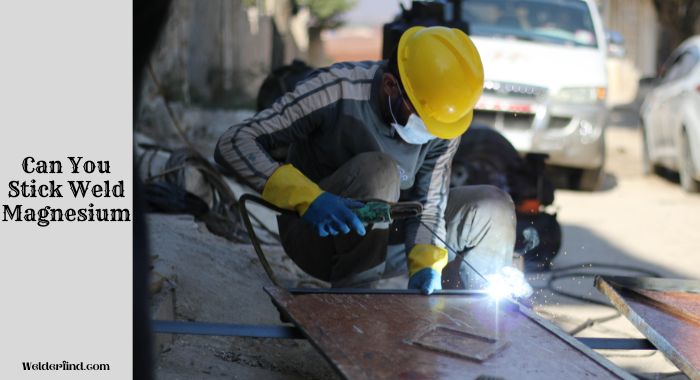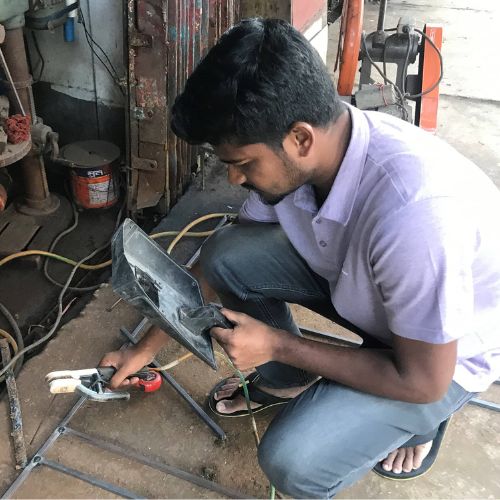Magnesium is a lightweight metal alloy used in manufacturing lightweight structures like aircraft components. Although it’s an excellent material for many applications, it may be difficult to weld due to its high reactivity.
Here, we’ll discuss how to stick weld magnesium, the required materials, and safety precautions.
Can You Weld Magnesium With A Stick Welder?

Yes, stick welding magnesium is possible, but it is not recommended. The process is similar to welding other metals, but you must follow some special precautions to ensure safety.
This manual arc welding process is done through the heat generated by an electric arc. In this process, the electrode melts and fuses with the metals, creating a solid bond between the two metal pieces.
Magnesium is a lightweight metal and highly reactive. It has a low melting point that makes it difficult to weld with traditional methods like stick welding.
In this process, the heat generated by the welding arc can quickly cause magnesium oxidation and create welding defects.
You can weld magnesium with a stick welder, but you must use special rods and an argon gas mixture for welding. It will require a lower current setting than welding other metals.
Materials You Need To Stick Weld Magnesium

There are some specialized materials that you will need to stick welding magnesium successfully. Here is a list of materials you will need for the process:
- Special Magnesium-Compatible Flux: you will need a particular type of flux, such as EZ33A, for stick welding magnesium because this flux core wire does not contain sodium chloride that erodes the metals over time.
- Welding Rods: no special welding rods are available for stick welding magnesium. You can use standard rods or low-hydrogen grades.
- Protective Clothing: You must wear fire-resistant protective clothes with long sleeves and long pants to protect yourself from sparks and molten.
- Heat-Resistant Gloves: You have to invest in a pair of highly heat-resistant gloves for welding magnesium.
- Amperage Meter: Since you have to ensure a lower current in this process, an amperage meter will help you control the current flowing through your magnesium workpiece. So, make sure to use an amperage meter.
How To Stick Weld Magnesium
Now, it’s time to know the process of stick welding magnesium. Here’s a step-by-step process:
Step 1: Set Up Your Welding Station
The first step in stick welding magnesium is to set up your welding station and ensure all the necessary equipment is at your arm’s length.
Also, ensure you have the proper safety gear like goggles, face masks, etc. You should wear heat-resisting gloves, long sleeve shirts, and trousers.
Step 2: Set The Welding Machine
You have to set your welding machine with the correct settings for magnesium welding. We already know that stick-welding magnesium needs less current than other materials.
So, the current of the welder machine should be between 30 and 50 amps and the voltage between 10 and 15 volts.
Step 3: Clean The Workpiece
Now it’s time to clean your workpieces. It is very crucial to clean the welding areas before starting the process. You can use a wire brush, sanding paper, or grinding wheel to remove dust, dirt, and grease from your magnesium workpieces.
Step 4: Select The Right Shielding Gas & Electrode
Electrodes and shielding gas are essential for welding magnesium gas. You have to use the right electrode and filler rod for the process.
Plus, make sure you use a suitable shielding gas as well. In this case, you must use Argon gas, the most commonly used gas for welding magnesium.
Step 5: Start Welding
At this point, it’s time to start the welding process. Strike the arc by bringing the electrode to your workpiece and then pull it back slightly. It will create a spark that will ignite the arc.
Then, move the electrode in a circular motion around the welding area. Ensure a constant arc length and speed while welding.
Step 6: Check Your Welding
Finally, when the welding is completed, check the welding area to ensure everything is okay. If you are satisfied with the welding, turn off the welding machine and remove the electrode.
What To Consider When Stick Welding Magnesium?
Stick welding is not the best option for magnesium. So, you must consider some crucial points when stick welding magnesium.
- Always preheat the magnesium workpiece before welding to reduce the risk of warping and cracking.
- You must use a specific filler rod specially designed for magnesium.
- Use a low voltage and low amperage setting in your welding machine.
- Move the filler rod slowly and steadily to make welding more robust.
- Let the welding area cool down naturally. Doing hurry can result in cracking or warping.
Magnesium Stick Welding: Common Mistakes & How Avoid Them
People sometimes make the following common mistakes while stick-welding magnesium:
Not Striking An Ark Correctly
It is vital for stick welding magnesium that you strike the ark correctly. You should strike it at the right angle and keep it steady. So, make sure the arc is consistent and concentrated.
Not Controlling the Heat & Current
These two are very crucial factors for stick welding magnesium. So, ensure the weld is not too hot and the welder machine produces less current.
Safety Precautions When Stick Welding Magnesium
Safety is an essential part of stick welding magnesium. We know that magnesium is very reactive. So, follow the safety measures mentioned below:
- Always wear protective gear, such as gloves, helmet, apron, etc.
- Shield your face and body from sparks.
- Make sure the work area is adequately ventilated.
- Monitor the welding temperature.
- Use the right filler rod.
Conclusion
Professional welders no longer use traditional welding processes like stick welding for magnesium.
There are several other ways available now, for example, TIG welding. However, if you must use stick welding for magnesium, follow the correct procedure and safety measures.
FAQs
What happens when you weld magnesium?
Magnesium is a highly reactive metal and creates bright white light and sparks while welding. The light is brighter than other metals, generating significant heat.
What is the best way to weld magnesium?
Now, TIG welding is the best way to weld magnesium with Argon gas to shield the welding area from oxidation. The process uses magnesium alloy as the filler rod.
What Stick welding rod to use for magnesium?
You won’t find any specific stick welding rod to use for magnesium. You can use magnesium alloy or low-hydrogen grade rods.
